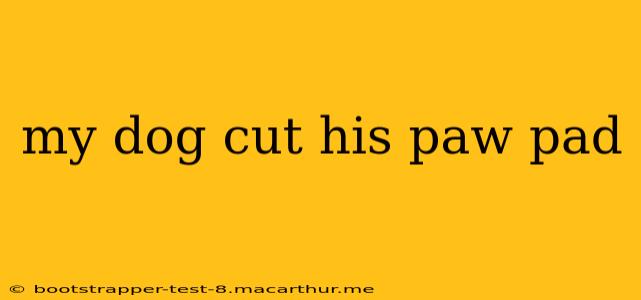My Dog Cut His Paw Pad: A Comprehensive Guide to Care and Treatment
Having a dog is a rewarding experience, but accidents happen. A cut paw pad is a common injury that can cause significant discomfort for your furry friend. Knowing how to assess the injury, provide first aid, and seek veterinary care is crucial for their well-being. This guide will walk you through everything you need to know about treating a cut paw pad in your dog.
How Can I Tell If My Dog's Paw Pad is Seriously Cut?
Assessing the severity of your dog's paw pad injury is the first step. Minor cuts may only require cleaning and observation, while deeper wounds need professional veterinary attention. Look for the following signs:
- Bleeding: A small amount of bleeding is common, but heavy or persistent bleeding requires immediate veterinary care.
- Depth of the Cut: Superficial scratches are usually less serious than deep cuts that expose underlying tissue or bone.
- Signs of Infection: Increased swelling, redness, pus, or a foul odor indicate a possible infection.
- Lameness: If your dog is limping significantly or avoiding putting weight on the affected paw, the injury may be more serious.
- Visible Bone or Tendon: This is a serious injury requiring immediate veterinary attention.
What Should I Do If My Dog Cuts His Paw Pad?
First aid for a minor cut on your dog's paw pad involves:
- Clean the Wound: Gently clean the area with warm water and a mild antiseptic soap. Avoid using hydrogen peroxide or alcohol, as these can damage the tissue.
- Stop the Bleeding: Apply gentle pressure to the wound with a clean cloth. If bleeding is profuse or doesn't stop after 10-15 minutes, seek immediate veterinary care.
- Apply a Bandage (If Necessary): For minor cuts, a thin layer of antibiotic ointment can be applied, followed by a bandage. Choose a bandage that allows for some air circulation and won't stick to the wound. Monitor the wound closely for signs of infection. Note: Some vets may advise against bandaging, especially for smaller cuts, as it can trap moisture and hinder healing.
- Keep Your Dog Calm and Restrict Activity: Confine your dog to a quiet area to prevent further injury to the paw.
When Should I Take My Dog to the Vet for a Paw Pad Cut?
You should consult a veterinarian immediately if:
- Your dog is exhibiting significant pain or lameness.
- The bleeding is heavy or doesn't stop after applying pressure.
- The cut is deep and exposes underlying tissue or bone.
- You notice signs of infection such as swelling, redness, pus, or a foul odor.
- The cut is located on a sensitive area like the webbing between the toes.
- You're unsure about the severity of the injury.
How Long Does it Take for a Dog's Paw Pad to Heal?
The healing time depends on the severity of the cut. Minor scratches may heal within a few days, while deeper wounds may take several weeks. Keep a close eye on the wound and follow your veterinarian's instructions for aftercare.
How Can I Prevent My Dog From Cutting His Paw Pads?
Prevention is always better than cure. Here are some tips to protect your dog's paw pads:
- Check your dog's paws regularly: Inspect your dog's paws after every walk, looking for any cuts, punctures, or foreign objects.
- Trim your dog's nails: Long nails can make your dog more prone to paw injuries.
- Avoid walking on hot surfaces: Hot pavement or sand can burn your dog's paw pads.
- Use paw protection: Consider using dog booties during walks in rough terrain, hot weather, or on icy surfaces.
- Be mindful of sharp objects: Keep sharp objects out of your dog's reach and clear paths of debris.
Remember, this information is for general guidance only. Always consult with a veterinarian for diagnosis and treatment of your dog's injuries. They can provide personalized advice based on your dog's individual needs and the specific nature of the injury. Early intervention can often prevent complications and ensure a speedy recovery for your beloved pet.
